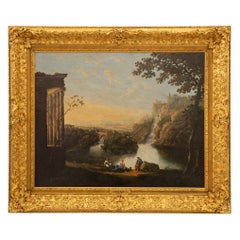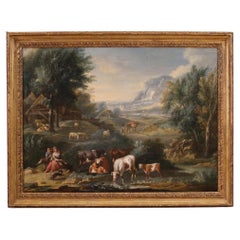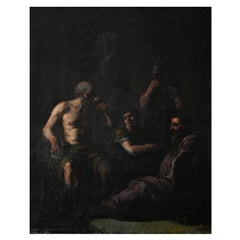Richard Wilson R.A. Furniture
to
1
1
1
1
1
1
1
1
1
1
1
1
1
1
2
12,385
3,859
2,504
2,228
Creator: Richard Wilson R.A.
Welsh 18th Century Oil On Canvas Painting By Richard Wilson
By Richard Wilson R.A.
Located in West Palm Beach, FL
A magnificent Welsh 18th century oil on canvas painting by Richard Wilson. The painting is framed within a striking and richly carved giltwood border with fine foliate designs and in...
Category
18th Century English Antique Richard Wilson R.A. Furniture
Materials
Canvas, Giltwood, Paint
Related Items
18th Century Oil on Canvas Italian Bucolic Landscape Painting, 1770
Located in Vicoforte, Piedmont
Venetian school of the second half of the 18th century. Oil painting on canvas depicting an Arcadian landscape of pastoral genre. This type of pictorial representation established it...
Category
1770s Italian Antique Richard Wilson R.A. Furniture
Materials
Canvas
$11,229
H 35.04 in W 44.89 in D 2.37 in
Socrates, 18th Century, Oil on Canvas, Unsigned
Located in Bozeman, MT
Death of Socrates, oil on canvas, Unsigned, 18th century possibly Italy.
Category
18th Century Italian Baroque Antique Richard Wilson R.A. Furniture
Materials
Canvas
Early 18th Century Oil on Canvas Laid on Board Painting, Italian School
Located in Round Top, TX
Original oil on canvas laid on panel painting, Italian school. Unsigned. Possibly a religious composition with three putti in lower left.
Condition: Age related craquelure, some abra...
Category
Early 18th Century Italian Antique Richard Wilson R.A. Furniture
Materials
Canvas, Wood, Paint
$3,500
H 31.25 in W 38.25 in D 1.5 in
Monumental 18th Century Painting, Oil on Canvas, Italian School
Located in Toronto, CA
This is a monumental and spectacular 18th century, or possibly early 19th, oil on canvas of the Italian school. The canvas depicts a shepherd serenading a maiden in a wooded glen. B...
Category
18th Century Italian Baroque Antique Richard Wilson R.A. Furniture
Materials
Canvas
18th Century Oil on Canvas Italian Antique Landscape Painting, 1750
Located in Vicoforte, Piedmont
Antique Italian painting from the mid-18th century. Oil on canvas artwork depicting a landscape with characters and architecture along the river, of good pictorial quality. Finely ca...
Category
1750s Italian Antique Richard Wilson R.A. Furniture
Materials
Canvas
$5,973
H 32.68 in W 49.61 in D 2.37 in
18th Century Oil on Canvas Italian School
By Carlo Maratta
Located in Marseille, FR
Painting with probably biblical Italian school characters End of the 17th beginning of the 18th century unsigned carrying a Carlo Maratta cartouche of in...
Category
Early 18th Century Italian Baroque Antique Richard Wilson R.A. Furniture
Materials
Canvas
Religious Oil on Canvas – European School, 18th Century
Located in Madrid, ES
Religious Oil on Canvas – European School, 18th Century
Dimensions: 50 x 45 cm (frame), 34 x 29 cm (view): San Carlos Borromeo, Archbishop of Milan (1538-1584)
A serene and contempl...
Category
18th Century European Baroque Antique Richard Wilson R.A. Furniture
Materials
Canvas
18th Century, Italian Pair of Oil on Canvas Paintings by Francesco Simonini
By SIMONINI
Located in IT
Francesco Simonini (Parma, 16 June 1686 - Parma, 1766)
“The rest of the soldiers” and “The march of soldiers”
oil on canvas
cm 40 x 58 and 40 x 60 ; frame: h 52,5 x W 70,5 x D 6 an...
Category
Early 18th Century Italian Baroque Antique Richard Wilson R.A. Furniture
Materials
Canvas
$27,955 Sale Price
35% Off
H 20.87 in W 28.75 in D 2.37 in
18th Century Oil on Canvas Italian Antique Architectures Painting, 1760
Located in Vicoforte, Piedmont
Antique Italian painting from the 18th century. Artwork oil on canvas (glued on a board) depicting a pleasant caprice, view with architectures and characters of good pictorial qualit...
Category
1760s Italian Antique Richard Wilson R.A. Furniture
Materials
Canvas
$4,778
H 36.23 in W 29.14 in D 1.19 in
18th Century Oil on Canvas Mythological Painting Medea, 1770
Located in Vicoforte, Piedmont
Great 18th-century mythological painting. Signed lower left by the great Austrian artist Joseph Hickel (1736-1807) and dated 1770. Court painter of the Habsburgs and a favorite of Em...
Category
1770s Austrian Antique Richard Wilson R.A. Furniture
Materials
Canvas
18th Century Portrait of a Gentleman Oil on Canvas
Located in Marseille, FR
18th century portrait of a gentleman oil on canvas.
Category
18th Century French Louis XVI Antique Richard Wilson R.A. Furniture
Large 18th Century Italian Oil On Canvas Painting Of Christ
Located in London, GB
A large scale (life size) 18th Century Italian oil on canvas.
'THE BODY OF THE DEAD CHRIST IN THE TOMB' after Hans Holbein the Younger, showing Christ lying in the tomb. His head re...
Category
18th Century Italian Folk Art Antique Richard Wilson R.A. Furniture
Materials
Canvas, Paint
Richard Wilson R.a. furniture for sale on 1stDibs.
Richard Wilson R.A. furniture are available for sale on 1stDibs. These distinctive items are frequently made of wood and are designed with extraordinary care. There are many options to choose from in our collection of Richard Wilson R.A. furniture, although brown editions of this piece are particularly popular. If you’re looking for additional options, many customers also consider furniture by Montague Dawson, Eleazar Albin, and Captain Greenvile Collins. Prices for Richard Wilson R.A. furniture can differ depending upon size, time period and other attributes — on 1stDibs, these items begin at $48,500 and can go as high as $48,500, while a piece like these, on average, fetch $48,500.


